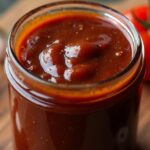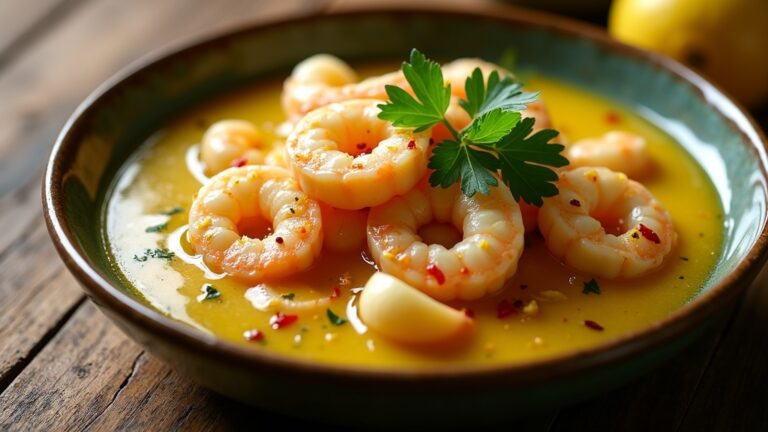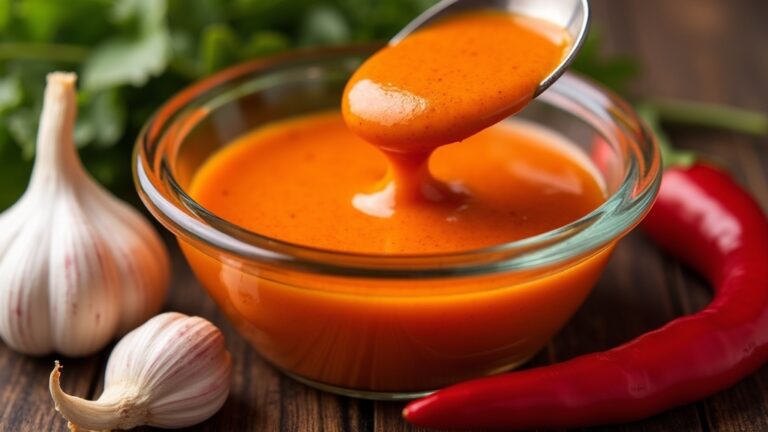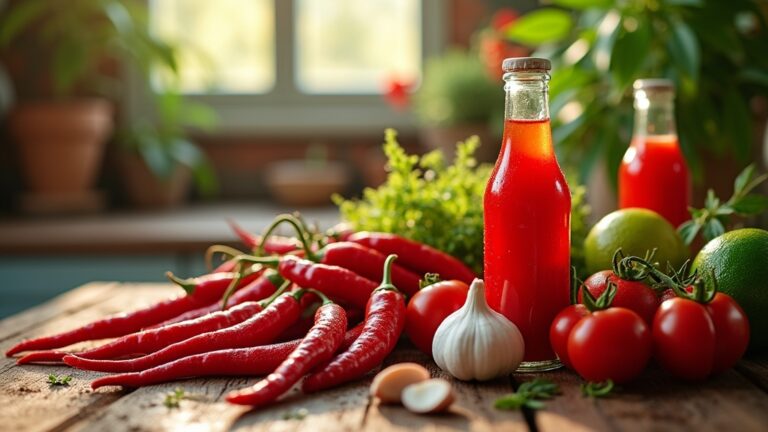Chili Sauce Recipe
I love making my own chili sauce, and it’s such a rewarding experience! For a basic recipe, you’ll need fresh red chilies, onion, garlic, apple cider vinegar, and brown sugar. Blend the chopped ingredients, simmer them to meld flavors, add the sugar to balance heat and tang, then bottle it up. It’s perfect for enhancing meals and can be customized with unique ingredients. If you’re curious about innovative pairings, there’s so much more to explore!
Contents
History
When I think about chili sauce, I can’t help but marvel at its rich history, which dates back centuries. This fiery condiment isn’t just about heat; it embodies cultural significance across various regions. In Mexico, for instance, chili sauce has roots in ancient traditions, fusing indigenous ingredients with European influences. Meanwhile, in Southeast Asia, distinct regional variations emerge, showcasing local spices and flavors that reflect each community’s palate. From the fiery sambals of Indonesia to the tangy salsas of Central America, each version tells a story of innovation and adaptation. As I explore the evolution of chili sauce, I appreciate how it brings people together, celebrating flavors while honoring the rich tapestry of culinary heritage.
Recipe
Chili sauce is a versatile condiment that can elevate a wide array of dishes, from tacos to grilled meats. Making your own chili sauce at home not only allows you to customize the heat and flavor but also guarantees that you know exactly what ingredients are going into it. This recipe strikes a perfect balance between spiciness, sweetness, and tanginess, making it a delightful addition to your culinary repertoire.
Chili sauce enhances a variety of dishes, allowing for personalized heat and flavor with fresh, wholesome ingredients.
Whether you’re looking to spice up your meals or need a zesty dip for appetizers, this chili sauce will not disappoint. With a few simple ingredients and easy steps, you’ll have a homemade sauce that rivals any store-bought version. So gather your ingredients, and let’s get started on creating this flavorful condiment that can be stored in your refrigerator for weeks.
Ingredients:
- 1 cup fresh red chilies (such as Fresno or red jalapeño), roughly chopped
- 1/2 cup onion, finely chopped
- 3 cloves garlic, minced
- 1/2 cup apple cider vinegar
- 1/4 cup brown sugar
- 1 teaspoon salt
- 1/2 teaspoon ground black pepper
- 1 tablespoon olive oil
- 1 teaspoon smoked paprika (optional)
To prepare the chili sauce, heat the olive oil in a medium saucepan over medium heat. Add the chopped onions and sauté until they are translucent, about 5 minutes. Then add the minced garlic and chopped chilies, cooking for an additional 2-3 minutes until fragrant. Pour in the apple cider vinegar, stirring in the brown sugar, salt, and pepper. Bring the mixture to a simmer and cook for about 15-20 minutes, stirring occasionally, until the chilies are soft and the sauce has thickened slightly. Once done, allow the mixture to cool before blending it into a smooth sauce.
When making chili sauce, feel free to adjust the heat level by choosing milder or hotter chilies based on your preference. You can also add other spices like cumin or coriander for an extra layer of flavor. For a smoother consistency, blend the sauce longer, or if you prefer a chunkier texture, pulse it briefly. Store your chili sauce in an airtight container in the refrigerator; it should last for up to 2 weeks. Enjoy experimenting with this recipe and make it your own!
Cooking Steps
Now that we’ve gathered all our ingredients, let’s jump into the cooking steps that will bring our chili sauce to life. First, I’ll chop the fresh chili peppers to release their vibrant flavors, then blend them with vinegar for that zesty kick. As we simmer the mixture, I’ll show you how to balance the heat with just the right amount of sugar before bottling it up for later enjoyment.
Step 1. Chop Fresh Chili Peppers
As I prepare to chop fresh chili peppers, I can already imagine the vibrant heat they’ll bring to my sauce. I carefully select a mix of pepper varieties, from fiery jalapeños to smoky chipotles, each offering a unique flavor profile. With a sharp knife in hand, I slice off the stems and split the peppers lengthwise, exposing their seeds. The aroma fills the air—spicy and invigorating. I remove the seeds to tone down the heat or leave them in for an extra kick. As I chop, I pay attention to my knife technique, aiming for uniform pieces that’ll cook evenly. This step not only enhances the sauce’s texture but also guarantees every bite is brimming with that fresh chili essence!
Step 2. Blend With Vinegar
Once I’ve chopped the fresh chili peppers to perfection, I reach for the vinegar, knowing it’ll elevate my sauce to a whole new level. I love experimenting with different vinegar types—apple cider, rice, or even balsamic—each bringing a unique tang that complements the heat of the peppers. As I pour the vinegar into my mixing bowl, I focus on flavor pairing; the acidity balances the spice, creating a harmonious blend. I mix the vinegar with the peppers until they’re fully incorporated, letting the vibrant colors and aromas mingle. This step is vital, as it sets the foundation for the sauce’s complexity. With the right vinegar, I’m not just making chili sauce; I’m crafting a culinary masterpiece that excites the palate.
Step 3. Simmer for Flavor Enhancement
To elevate the flavors of my chili sauce, I turn to the simmering pot, where all the magic happens. Using effective simmering techniques, I gently heat the blended mixture, allowing each ingredient to release its essence. As the sauce bubbles, I can almost feel the vibrant flavor profiles melding together—each spice, herb, and pepper harmonizing into a rich tapestry of taste. I keep the heat low, letting it simmer for at least 30 minutes, stirring occasionally to prevent sticking. This slow cooking not only enhances the sauce’s depth but also develops a rounded flavor that’s simply irresistible. I can’t rush this process; patience is key to achieving that perfect balance and complexity in every delicious drop.
Step 4. Add Sugar to Balance Flavor
Adding sugar to my chili sauce transforms the flavor profile, balancing the heat and acidity with a hint of sweetness. I usually start with a tablespoon of brown sugar, stirring it in gradually, tasting as I go. This step isn’t just about sweetness; it’s essential for achieving that perfect sweetness balance that elevates the whole dish. The sugar enhances the flavors, allowing the spices to shine while taming any overpowering heat. If you’re feeling adventurous, experimenting with alternative sweeteners like honey or maple syrup can add unique dimensions. Remember, the goal is to create a harmonious blend that excites your palate. By embracing this simple yet impactful addition, you’ll achieve a chili sauce that’s not only delicious but innovative, too.
Step 5. Bottle and Store Sauce
After you’ve perfected your chili sauce, the next step is bottling and storing it properly to maintain its flavors and freshness. I recommend choosing a bottle design that’s not only functional but also visually appealing. Glass bottles work wonders, as they’re non-reactive and can showcase your vibrant sauce. Make sure to sterilize your bottles before pouring in the sauce to prevent any spoilage.
When filling, leave about an inch of headspace to allow for expansion. For storage tips, keep your bottled sauce in a cool, dark place to preserve its taste. Once opened, store it in the fridge. This way, you can savor that homemade chili sauce for weeks, adding a burst of flavor to your meals!
Nutritional Guide
While I relish the bold flavors of chili sauce, I also find it essential to contemplate its nutritional aspects. Understanding the nutritional benefits helps me make informed choices about what I’m adding to my meals. Here’s a quick ingredient analysis of the common components in chili sauce:
| Ingredient | Calories | Nutritional Benefits |
|---|---|---|
| Tomatoes | 18 | Rich in vitamins C & K |
| Peppers | 20 | High in antioxidants |
| Vinegar | 3 | Supports digestion |
This table highlights how each ingredient packs a punch of flavor alongside valuable nutrients. By being aware of these benefits, I can confidently use chili sauce to enhance not just my dishes but also my overall health.
Final Thoughts
As I wrap up this exploration of chili sauce, I can’t help but appreciate how it transforms ordinary meals into extraordinary culinary experiences. The beauty of chili sauce lies in its versatility; whether you opt for classic recipes or venture into exciting sauce variations, there’s a flavor profile waiting to elevate your dishes. I’ve discovered that experimenting with different ingredients can lead to delightful surprises, making each batch uniquely yours. Pairing your chili sauce with unexpected flavors can create a symphony on your palate—think mango, garlic, or even chocolate! So, don’t shy away from being innovative in the kitchen. With the right sauce and flavor pairings, your meals can become a thrilling adventure, inviting friends and family to savor every bite.
Frequently Asked Questions
Can I Substitute Fresh Peppers With Dried Ones?
I’ve found that using dried peppers instead of fresh ones can elevate the flavor intensity. Just remember, dried peppers pack a stronger punch, so adjust your quantities for that bold kick you’re after!
How Long Can Homemade Chili Sauce Be Stored?
Did you know homemade preservation can keep your creations tasty for up to two weeks in the fridge? I love using airtight storage containers to guarantee my chili sauce stays fresh and flavorful for longer.
Is Chili Sauce Gluten-Free?
I’ve discovered that many chili sauce brands use gluten-free ingredients, but it’s essential to check labels. I love experimenting with different sauces, ensuring they fit my gluten-free lifestyle while still delivering bold flavors.
What Dishes Pair Well With Chili Sauce?
When I think of fiery sunsets, I picture spicy tacos and grilled chicken dancing on my plate. Their flavors ignite a culinary adventure, and chili sauce brings that exhilarating heat, transforming every bite into a vibrant experience.
Can I Adjust the Spice Level in the Recipe?
I love experimenting with spice adjustment techniques. Depending on my heat tolerance preferences, I start small, adding chili powder or fresh peppers, then taste-testing until I hit that perfect balance of flavor and heat.
Conclusion
As I stirred the bubbling pot of chili sauce, memories of family gatherings filled my mind, each spoonful a burst of flavor like laughter shared around the dinner table. Just as each ingredient contributes to the sauce’s vibrant character, every moment we savor together adds spice to life. So, don’t hesitate to whip up this recipe—it’s not just a condiment, but a way to bring loved ones closer. Enjoy the heat and heart in every drop!






